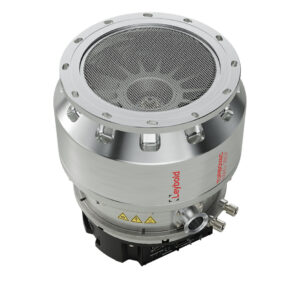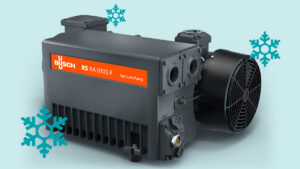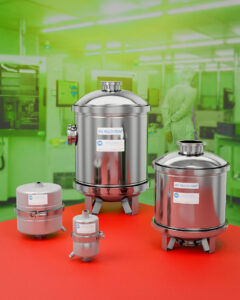Pfeiffer Vacuum Presents Solutions for Use in Laboratory Technology, Analytics and Biotechnology
With the HiPace family, Pfeiffer Vacuum has established a compact and powerful series in the analytical market. The outstanding feature of these turbopumps is their unique rotor design with the proven hybrid bearing, which Pfeiffer Vacuum invented more than 30 years ago and has continually advanced ever since.
These technical characteristics make for extremely high pumping speeds, high critical backing pressure and gas throughput, as well as very good compression for light gases. The turbopumps work particularly quietly and with only minimal vibration. The bearings also result in long service intervals and thus a high degree of efficiency. The functional aluminum housing makes the pump extremely light. A sealing gas connection safeguards the bearings against particles or oxidizing gases. The result is an optimal integration of the pumps. The long lifespan and with that the high system availability, set new standards.
When looking at a successful process of an entire production, vacuum often has a key position. Faulty batches or production downtime, depending on the application, can quickly cost several million euros. All the more important is the maximum reliability for all installed components. Today, turbopumps often reach an operating life of up to 100,000 hours. This corresponds to an uninterrupted lifetime of about eleven years. During this time, they should cause as few as possible planned interruptions for maintenance or service work. Therefore, Pfeiffer Vacuum turbopumps have advanced diagnostic functions. In conjunction with the unique property that the exchange of bearings and equipment in these pumps can be done in the field, it results in the highest possible availability. The integrated drive electronics for the turbopumps reduces the effort required for wiring considerably. Advanced drive technology minimizes energy consumption, the control options are varied.
SplitFlow Turbopumps - For the simultaneous evacuation of several chambers
The SplitFlow turbopump technology by Pfeiffer Vacuum enables multiple pumping systems to be replaced by a single vacuum system. One single SplitFlow pump can be used as a double or triple inlet pump to simultaneously evacuate two or three chambers of a series-connected mass spectrometer system. Depending on the gas load, small and economical dry diaphragm pumps can be used as backing pumps. This means a significant reduction in investment and operating costs. Another key advantage is the small footprint of the vacuum system. The pumping speed of the SplitFlow pumps extends generally in the range of 690 l/s to 10 l/s. Small models with a pumping speed of 10 l/s to 0.1 l/s have been designed for portable analysis systems.
The SplitFlow pumps are not only used in analytical instruments, but also successfully used in leak detectors, where their analysis principle is also based on mass spectrometry.
Multi-Stage Roots pumps ACP - Dry backing pump for particle-free applications
The multi-stage Roots pumps of the ACP series of adixen by Pfeiffer Vacuum are suitable for all vacuum applications where extreme cleanliness of the vacuum process is required. A special feature of the pump is that the pump system is composed of non-wearing parts. This allows for unmatched durability and high reliability even in demanding applications. The ACP is the oil-free alternative to traditional oil-sealed rotary vane pump. Since the ACP has no seals between the individual pump stages that wear out and the rotors are running without any contact, no seal wear occurs in the pumping system, as is the case with the other oil-free pumps. The motor with frequency converter ensures constant performance of the ACP, regardless of mains voltage and frequency.
High flow gas ballast ports and external drainable silencers allow the ACP to pump high amounts of condensable vapors (up to 1,000 g/h of pure water vapor).
Integrated pressure measurement - Direct installation, no special wiring
The combination of generating vacuum and measuring vacuum is the new concept of the integrated pressure sensors. Very small vacuum measuring sensors are attached to the Pfeiffer Vacuum turbopumps or Pfeiffer Vacuum chambers. The advantage is that this combination has only one electrical interface. This allows an easier installation for the user. Complicated wiring, software and hardware adjustments are things of the past. This saves time and money. The sensor communicates digitally with the turbopump, which creates a more reliable pressure signal than via an analog transmission. This pressure signal can be retrieved along with the status information of the turbopump, such as rotation speed, power consumption, etc. via the RS-485 interface.
Source: Pfeiffer Vacuum GmbH







